If you’re in the market for a tent, deciding which type best fits the outings you’ve planned can be difficult. But choosing the right tent type is vital to any successful camping trip, whether you’re a seasoned camper, an occasional weekend warrior, or completely new to the game.
Today, camping tents come in ample shapes and sizes, each designed to perform best in one or another weather conditions, destinations, and groups of people. While you can always go for the most popular options on the market, that’s not necessarily the best idea – what fits one isn’t inevitably a winner for another. So hunt for a tent that’s right for your particular scenario.
In this blog post, we’ll break down 20 different types of tents, their benefits, and uses so you can decide what best suits you – from light and easy-to-set-up tents for the casual hiker or a light backpacker to more robust, family-sized tents for extended stays in the wild.
- 1. Dome tents
- 2. Backpacking tents
- 3. Pop-up tents (Instant tent)
- 4. Tunnel tents
- 5. Inflatable tents
- 6. A-frame tents (Ridge tent)
- 7. Multi-room tents
- 8. Cabin tents
- 9. Truck tents
- 10. Geodesic tents
- 11. Teepee tents (Tipi tent)
- 12. Bivy tents
- 13. Rooftop tents
- 14. Canopy tents
- 15. Beach tents
- 16. Suspended tents
- 17. Bell tents
- 18. Hammock tents
- What to look for when choosing a tent
1. Dome tents

Dome tents offer an outstanding balance of space and affordability. What sets a dome tent apart is that it usually has two arched poles, which come together to form an apex at the top, giving it its distinctive dome shape.
They have triangular sidewalls that provide plenty of interior room – so much that you can even comfortably fit a large group if you go for a larger-sized dome tent. Plus, the design gives more headroom, at the same time causing water to slide down the exterior walls easier.
Dome tents can be either single or double-wall. Single-walled models sacrifice some ventilation for waterproofness; while double-walled dome tents have two layers – one mesh-made for ventilation and bug protection, second for weather protection so you can adjust the setup depending on weather conditions you’re off to. Sometimes, a tent footprint also comes together in the package.
On the downside, they’re not the best option in strong winds as they can catch the wind and be toppled quite easily.
2. Backpacking tents
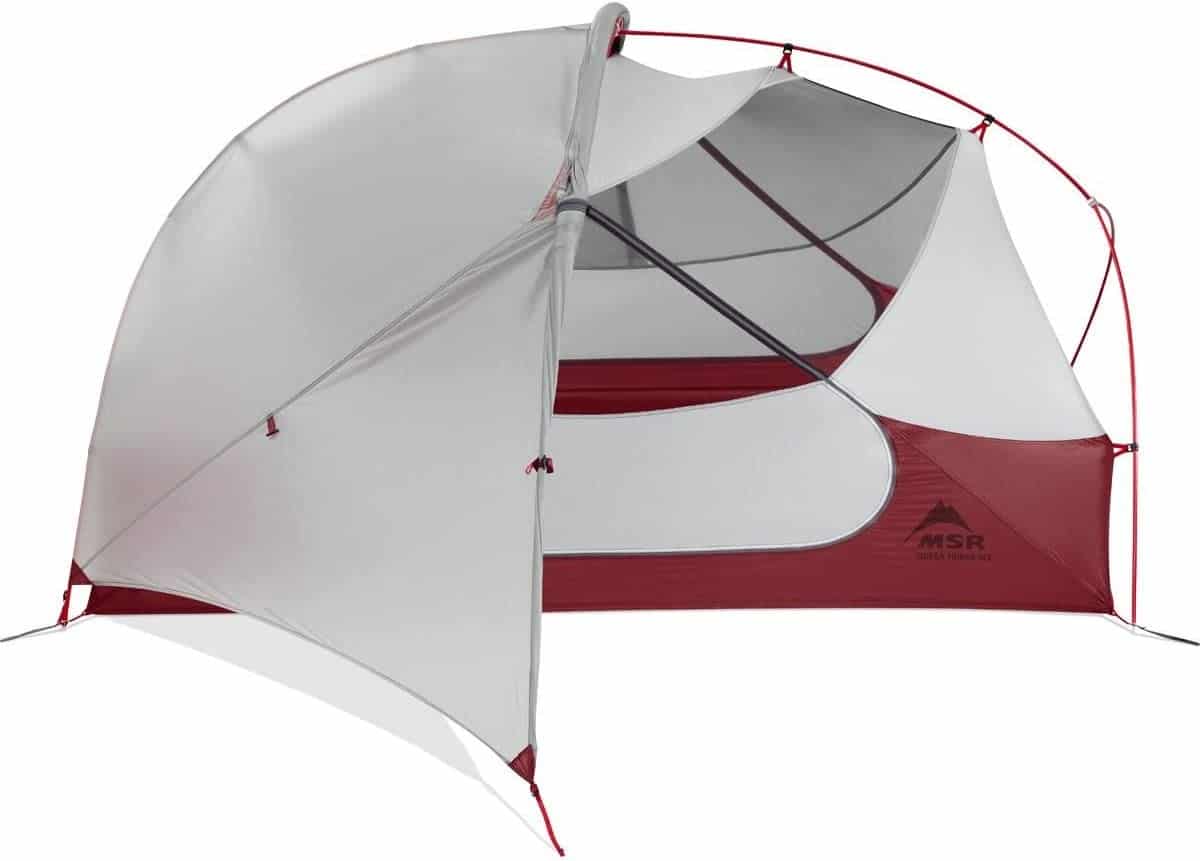
Backpacking tents are a unique type of tent that offer some distinct advantages to those looking for advanced portability and performance on the go.
As the name suggests, these tents are designed with long-distance travel and rugged conditions in mind, making them an ideal choice for hikers and campers without easy access to shelter or supplies.
What sets these tents apart is their lightweight construction (usually made of nylon), often featuring few internal poles, which ensures extreme compactness when folded or collapsed.
In terms of physical appearance, a backpacking tent usually comes in a classic domed shape with support poles and a large rain fly. However, the lightweight materials used in their construction may not be suitable for extreme weather conditions like high winds and heavy snowfall.
All in all, backpacking tents are ideal for travelers looking for smaller tents without compromising quality.
If you’re in a hunt for small 2-person tents, check out our detailed review where we handpicked the best options on the market.
3. Pop-up tents (Instant tent)
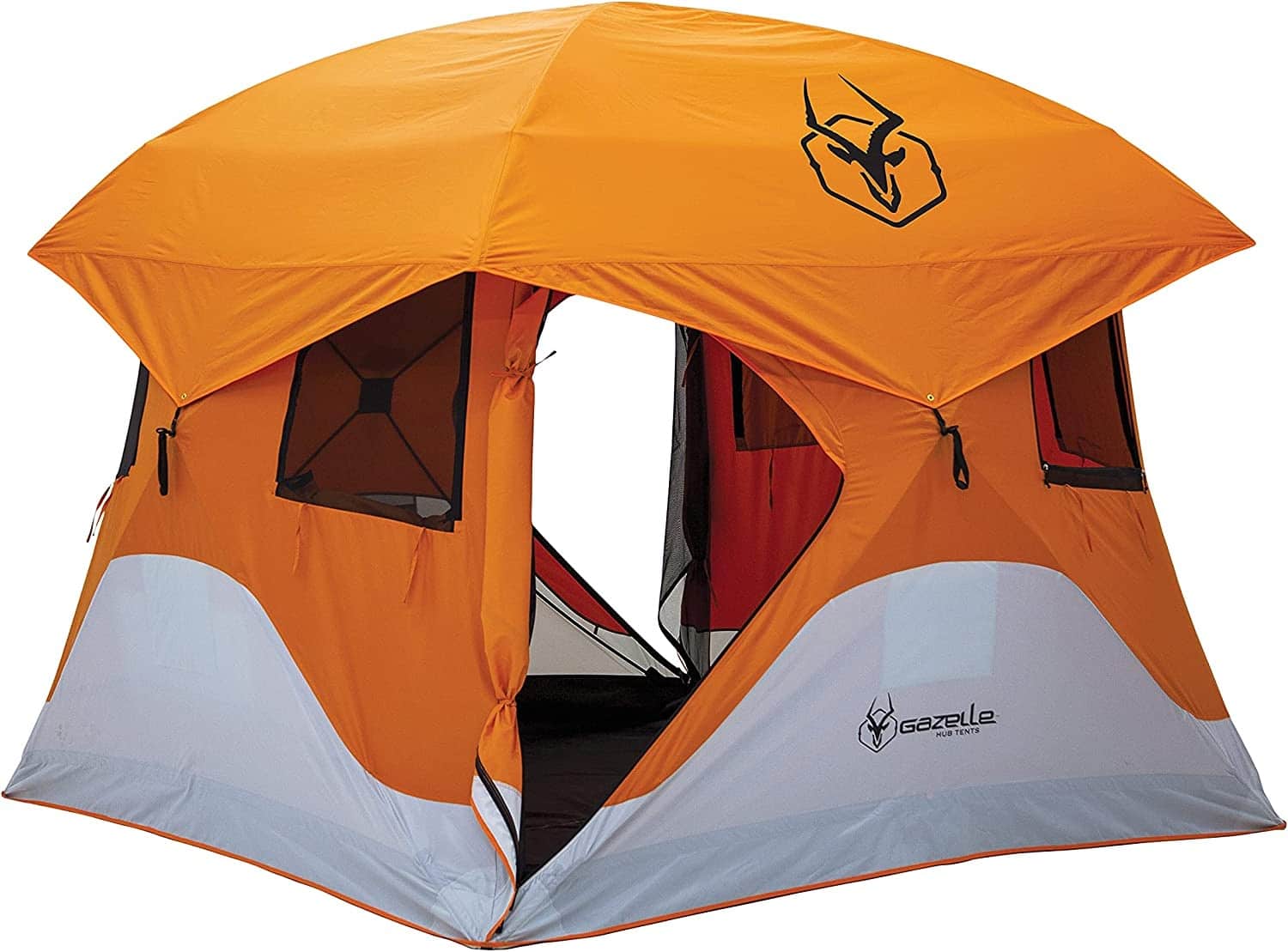
Pop-up tents have become increasingly popular because they are relatively affordable and require little setup time and skill. These tents offer a different take on traditional tent types since they snap into place in a matter of seconds.
Their unique design makes them both lightweight and easy to install, making them perfect for casual camping trips or even short-term use for those who don’t want to haul out an enormous tent setup. A pop-up tent can also be an excellent choice for Halloween decorations or makeshift playhouses for children.
However, there may be better choices for extreme weather conditions as they may lack certain features like the insulation needed to keep warm in cold climates. Plus, they’re not suitable for long-term adventures as they’re less stable.
4. Tunnel tents
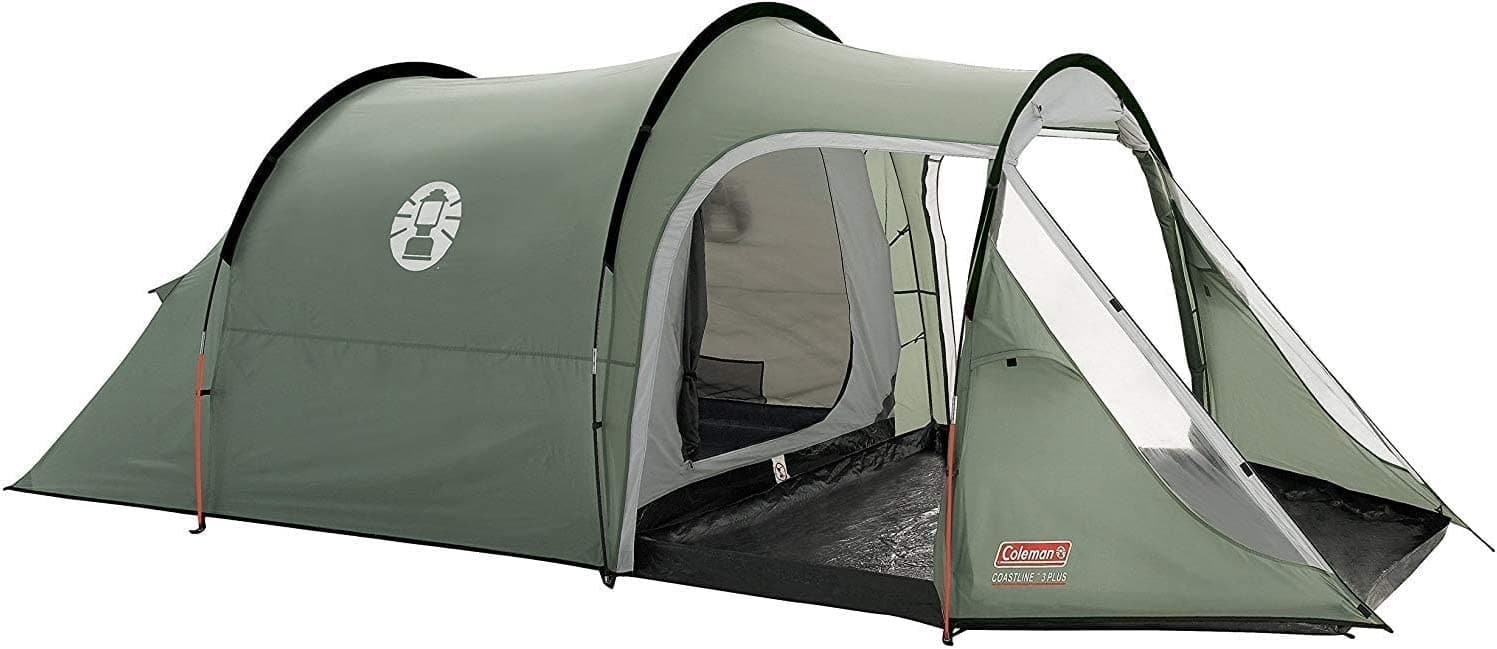
Tunnel tents are a popular tent type, offering great versatility and freedom compared to other types.
They usually comprise one or two flexible poles forming a tunnel-like shape, giving the tent a distinctive look. As such, they create an extremely spacious interior with plenty of headroom.
The main benefit of these tents is that they’re quick and easy to set up, typically requiring just one person. Tunnel tents strike many as a great fit for longer camping trips because they offer more interior space while benefiting from outstanding stability even in strong winds.
You can also use them in smaller, car camping trips providing just the right amount of room without taking up much of it. That said, a tunnel tent might not be the best choice if you want to pitch away from flat land or hard ground as they don’t support well on an uneven surface.
They’re great for group camping trips or festivals as they fan out in the front and side to provide generous space for each individual to sleep or store gear – but they can be too large and cumbersome for solo campers or those looking for lightweight equipment.
5. Inflatable tents
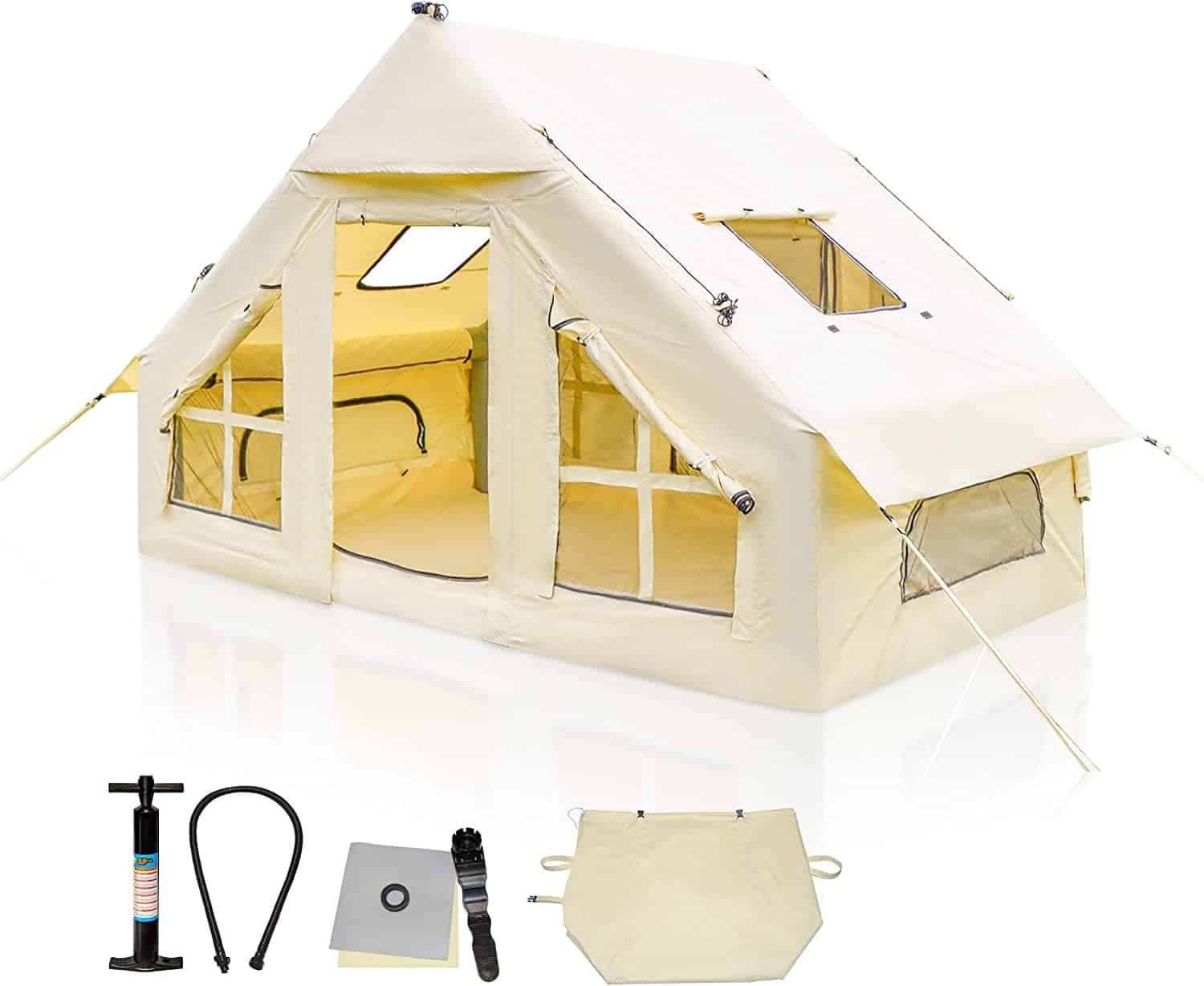
Inflatable tents have revolutionized camping and are a great choice for serious adventurers and casual campers alike. Instead of traditional tents with tent poles requiring you to set up the frames and clips, an inflatable tent creates an air-filled frame using an air pump.
They’re usually made with robust fabrics and feature a single-inflation point system that helps facilitate easy setup and takedown.
They come in various shapes, sizes, and types – from lightweight designs to larger versions intended for family events – making them ideal for multi-purpose camping trips. Inflatables can be used in more demanding environments; since they are solid and stable, they are perfect for adverse weather conditions like heavy snow or wind.
That said, inflatable tents may not be suited to those seeking a minimalist camping experience.
6. A-frame tents (Ridge tent)

As one of the tents around today, it stands out with its rigid structure and low center. They have a particular design with an A-shape, hence the name, that includes two poles crossing each other near one corner that anchors the tent into place.
This type of tent has a unique look compared to other types of tents as it utilizes triangular side walls, which maximize headroom and floor space.
Another distinguishing feature is that this tent can be pitched easily and is suitable for windy spaces without compromising structural integrity.
It’s an ideal choice for smaller families or space-limited campers. On the flip side, you may find that some types are not well suited for heavier weather conditions – like snow or extreme winds – because the shape does make it susceptible to collapsing at higher pressures than other types of tents.
They also lack an extra layer of protection in comparison to other types of tents.
7. Multi-room tents
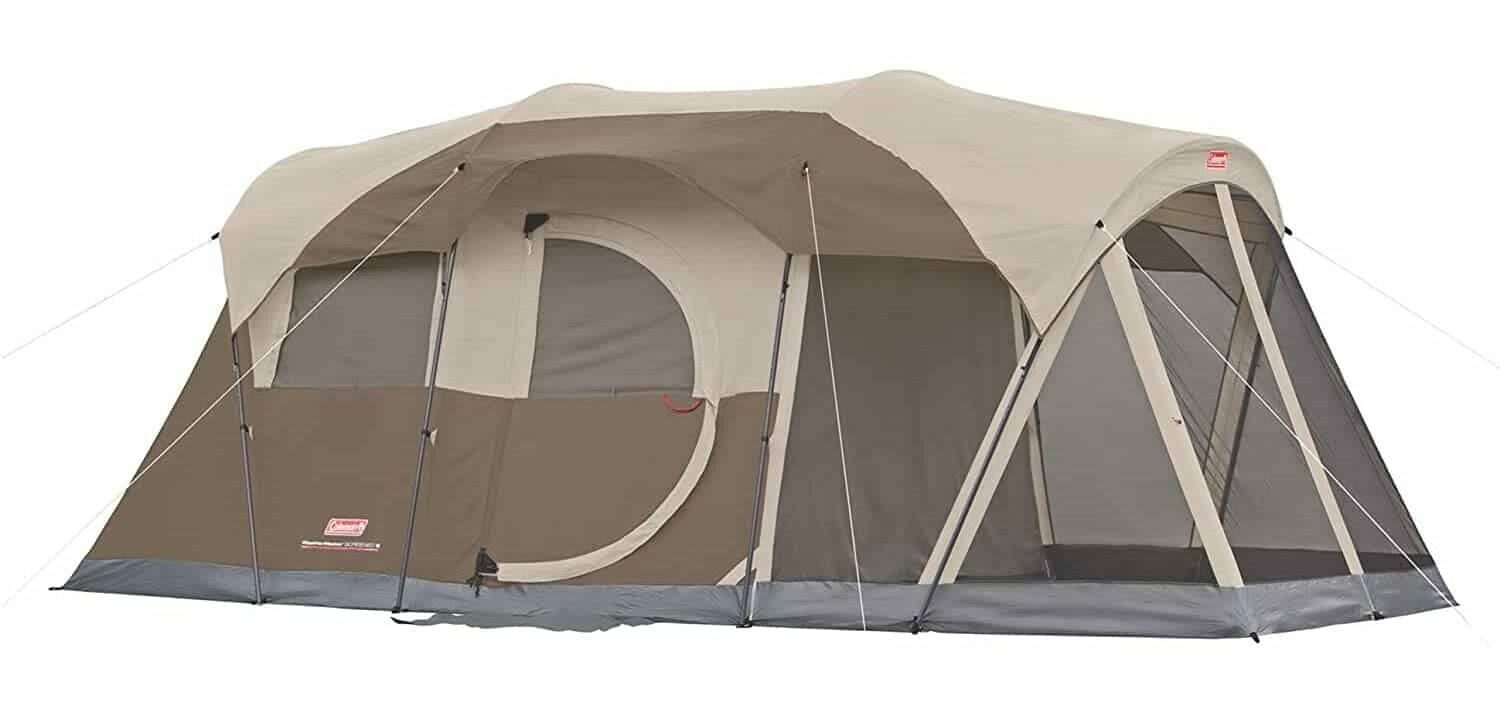
Multi-room tents are types of tents that are great for those looking for extra space and flexibility. Depending on size and model, a multi-room tent can fit anywhere from two to a dozen people, so it’s great for larger groups looking for a convenient way to sleep while out in the wild.
Multi-room tents look like regular tents, but they come with other additional features, such as big off-center doors able to fit large items in storage compartments or tall windows for natural light in all areas while providing sufficient ventilation.
They’re made with a series of interconnected poles that support the whole structure and its framework is covered with waterproof fabric. With some models offering several interconnected rooms, you can choose the best configuration and enjoy privacy while camping.
Although usually heavier than other types of tents due to the modular design, multi-room tents offer the advantage of having plenty of room for couples and families who require privacy and functionality during their outdoor travels.
However, multi-room tents might not be suitable for short trips, as they’re heavier and take some time to put together due to their complex structure. Plus, it’s usually more expensive than other types of tents.
8. Cabin tents
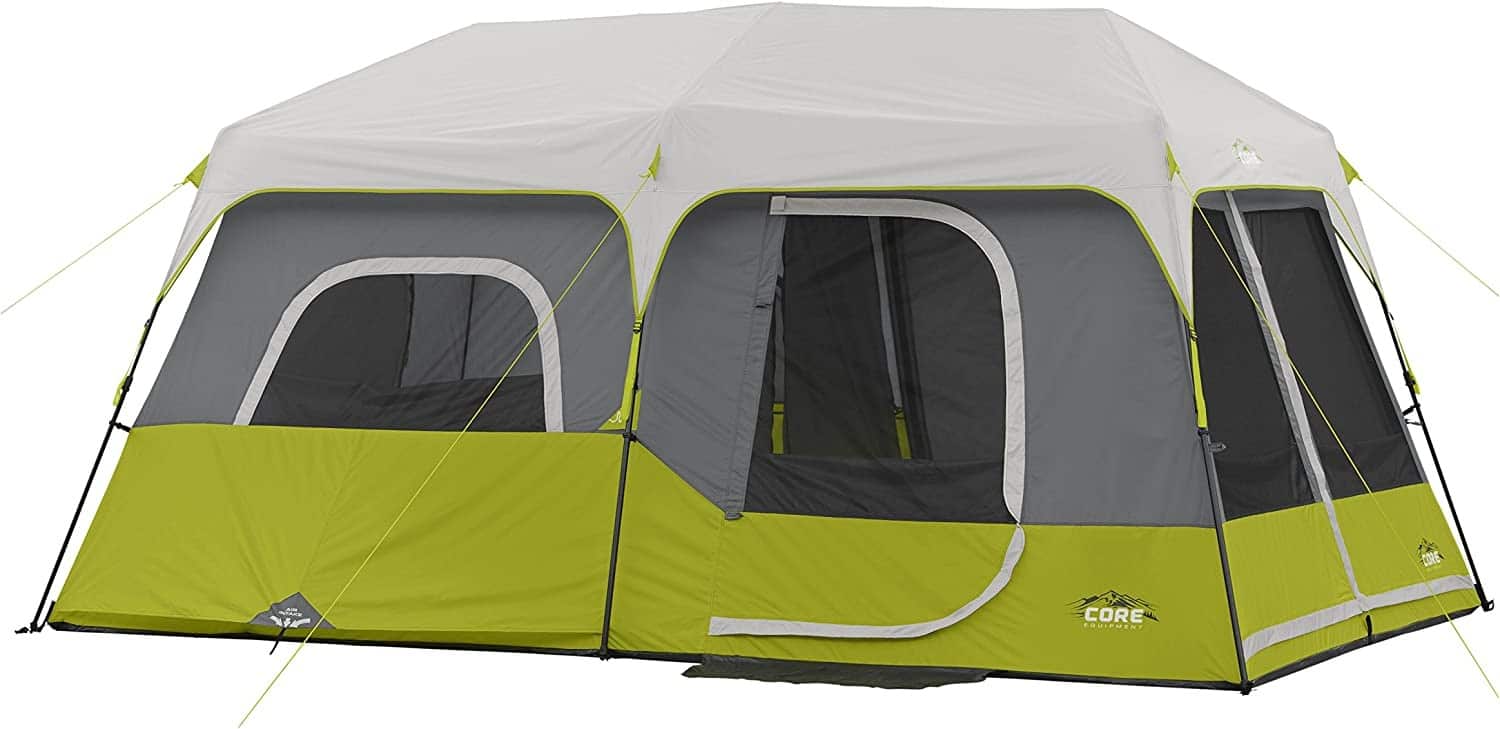
A cabin tent is one of the types of tents available on the outdoor gear market, and it stands out from other types with its attention to detail and a fantastic range of features. It looks like a small house, as it’s built to be spacious with a rectangular shape and high ceilings.
It offers extra space for recreational activities and easy setup and takedown processes. Cabin tents usually require at least two people working together due to its size (often 10 x 10 ft or larger).
With heavier materials that provide greater stability during windy conditions, these tents are great options for family camping trips or weekend getaways with friends.
9. Truck tents
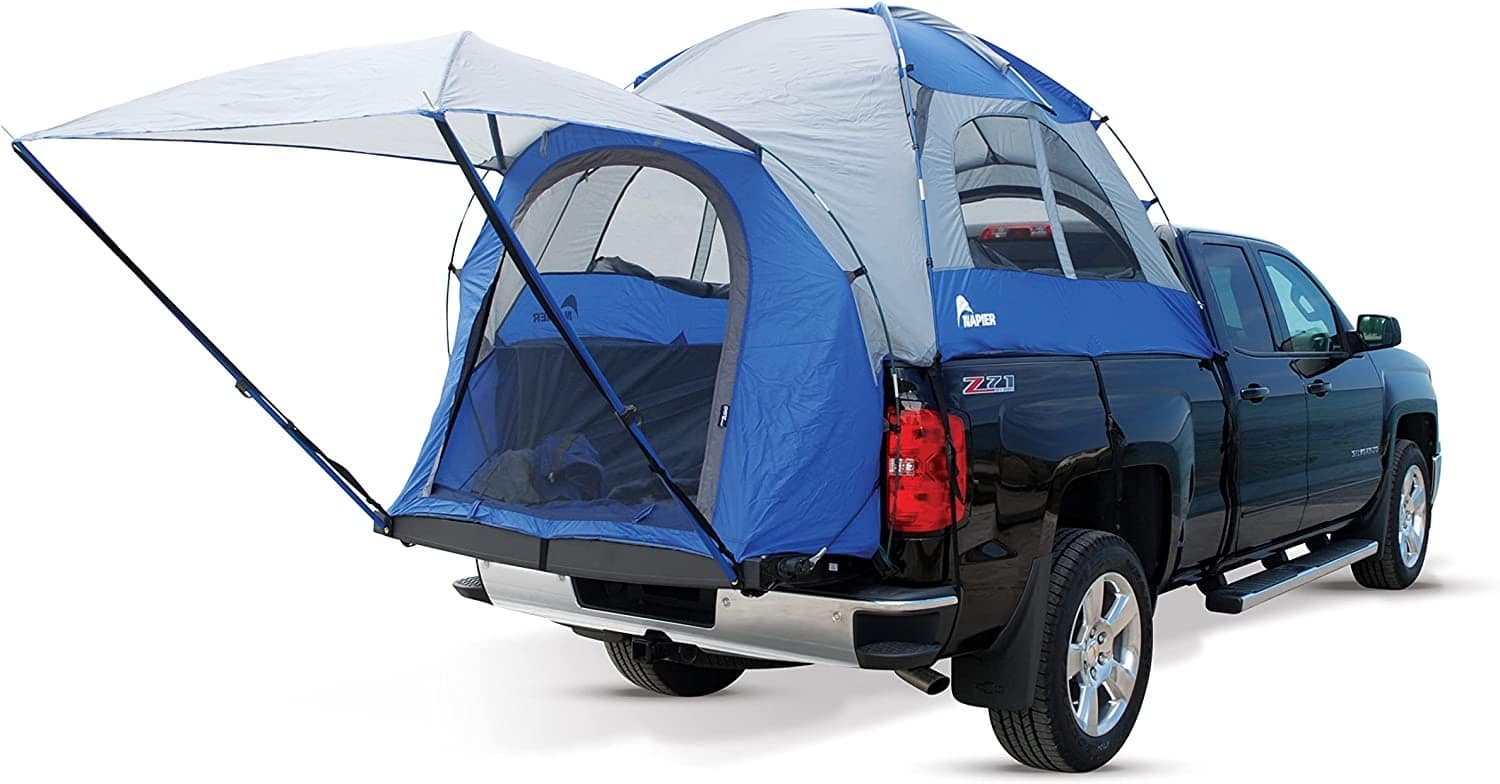
What sets a truck tent apart from the traditional types is that it’s designed to be set directly on top of a pick-up bed. This makes camping very convenient since it adds more comfort and freedom when it comes to sleeping arrangements.
When fully set up, these tents have an aerodynamic shape – shaped like a dome or cabin, depending on the model chosen – that maximizes headroom and offers lots of ventilation.
Design aside, truck tents are best for those who prefer off-ground sleeping in areas that require portability; it’s not particularly suitable for long-term camping, super extreme weather conditions, or large groups of people.
10. Geodesic tents

Geodesic tents (or semi-geodesic tents) are an advanced option for campers. They’re designed with durable construction and often feature heavy-duty materials to withstand wind, rain, and snow.
Their key feature is its strong yet lightweight structure of connected poles that form the geodesic dome shape. This provides increased strength and stability, making this type of tent one of the best-suited options for extreme conditions, such as high winds, heavy rains, extended outdoor use, and dense terrains.
Geodesic tent structure also maximizes internal living space while remaining lightweight and easy to carry, making it a great choice for those who want plenty of room without too much extra weight.
When camping in sunny weather in a primarily flat landscape (for example, a beach), you may prefer alternative types of tents due to their simplicity in setup and breakdown.
Plus, these tents are usually unsuitable for large families due to their generally smaller size; however, a geodesic tent could make for an ideal solution for solo campers or small groups.
11. Teepee tents (Tipi tent)
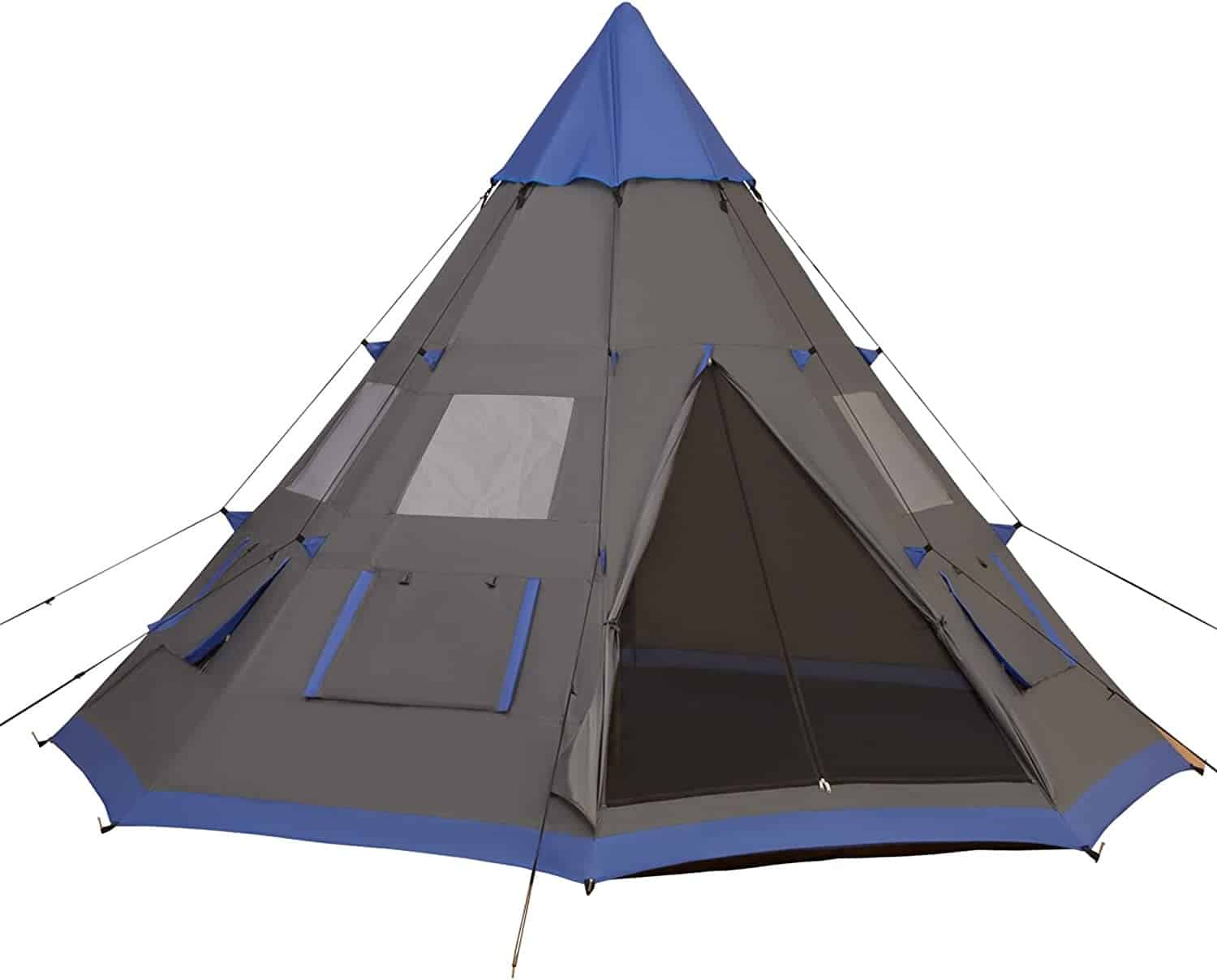
A teepee tent (or a tipi tent) is a fantastic structure and one of the oldest types today. It derives its name from the Sioux tribe, the indigenous people of North America, who lived in domed tents of animal skin.
Tipi tents are different from most other types because they require more setup. They are usually made with heavy-duty canvas with plenty of ventilation for warmer climates; tipis give off an eccentric vibe and provide ample space to sleep comfortably.
These tents come in a unique conic shape featuring a pointed entrance and airy slits at the highest point for ventilation. This classic design allows for a tremendous all-weather shelter since you can easily set it up with twin layers to provide extra sun protection during summer.
Due to the spacious layout tipi tent isn’t suitable for backpacking; however, if you want to stay warm in the wintertime, this will prove to be better than a regular camping tent due to its enhanced insulation capacity. Also, tipi tents are expensive picks that won’t be the go-to way for those shopping on a budget.
A very similar type to tipi are pyramid tents, of which the key difference lies in a less tapered shape.
12. Bivy tents
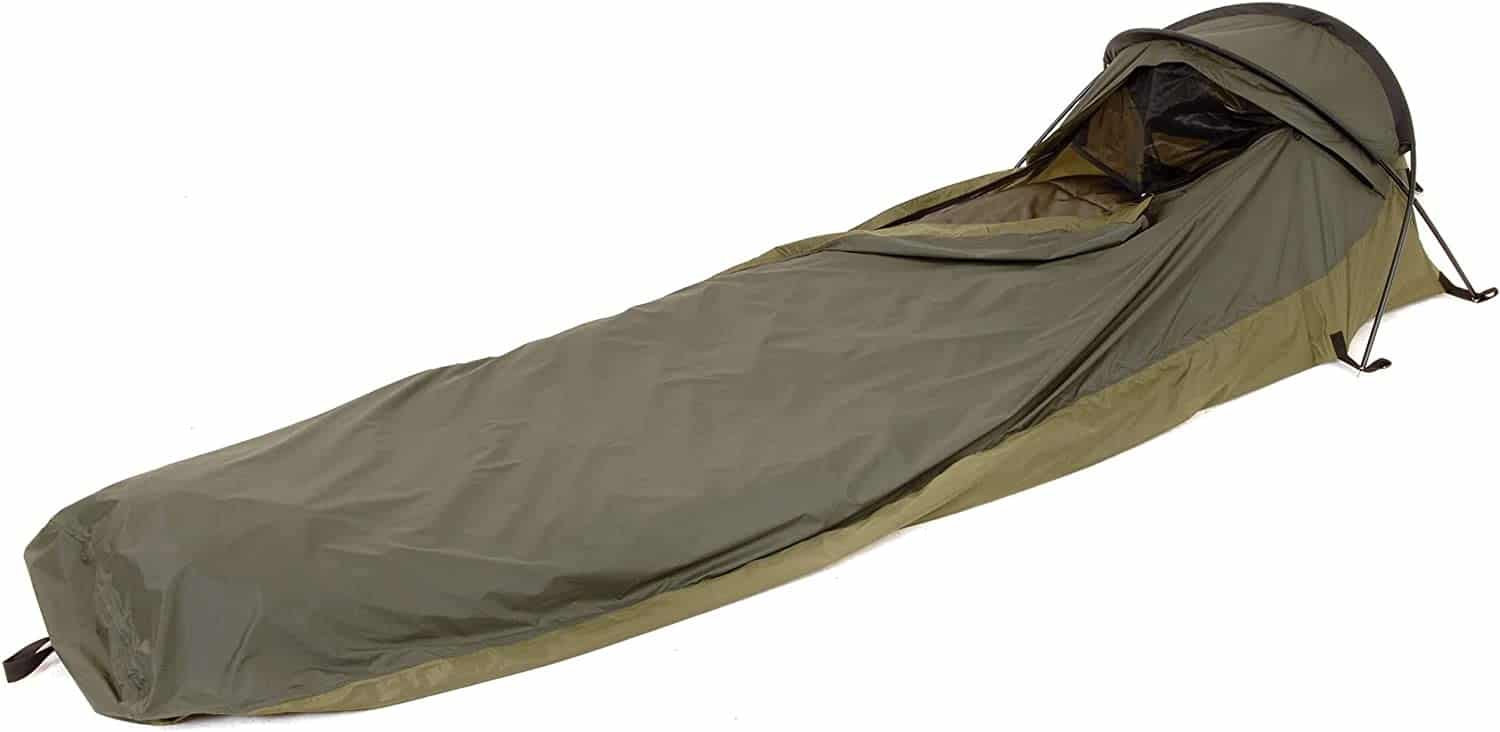
A bivy tent can be an excellent solution for travelers, adventurers, and campers who are always on the go.
Bivies are perfect when space, weight, and convenience matter more than anything else – they are ultra-lightweight and compact compared to regular types of tents but still give enough room to accommodate one person.
A bivvy differs from other types of tents because it is more a sleeping bag cover than an actual tent setup – there’s no need to employ poles. This makes it the most lightweight and convenient way of camping.
They come in all shapes and sizes, some made with waterproofing fabric and nets for bug protection or breathability, or both. Provided that you don’t need any extra space or planning on bringing a lot of gear, a bivy is an ideal combination of portability, affordability, and comfort.
While they protect against the elements, their minimalist construction generally isn’t suitable for more leisurely camping in areas with multiple people. Plus, note that space is limited in these types of tents.
13. Rooftop tents
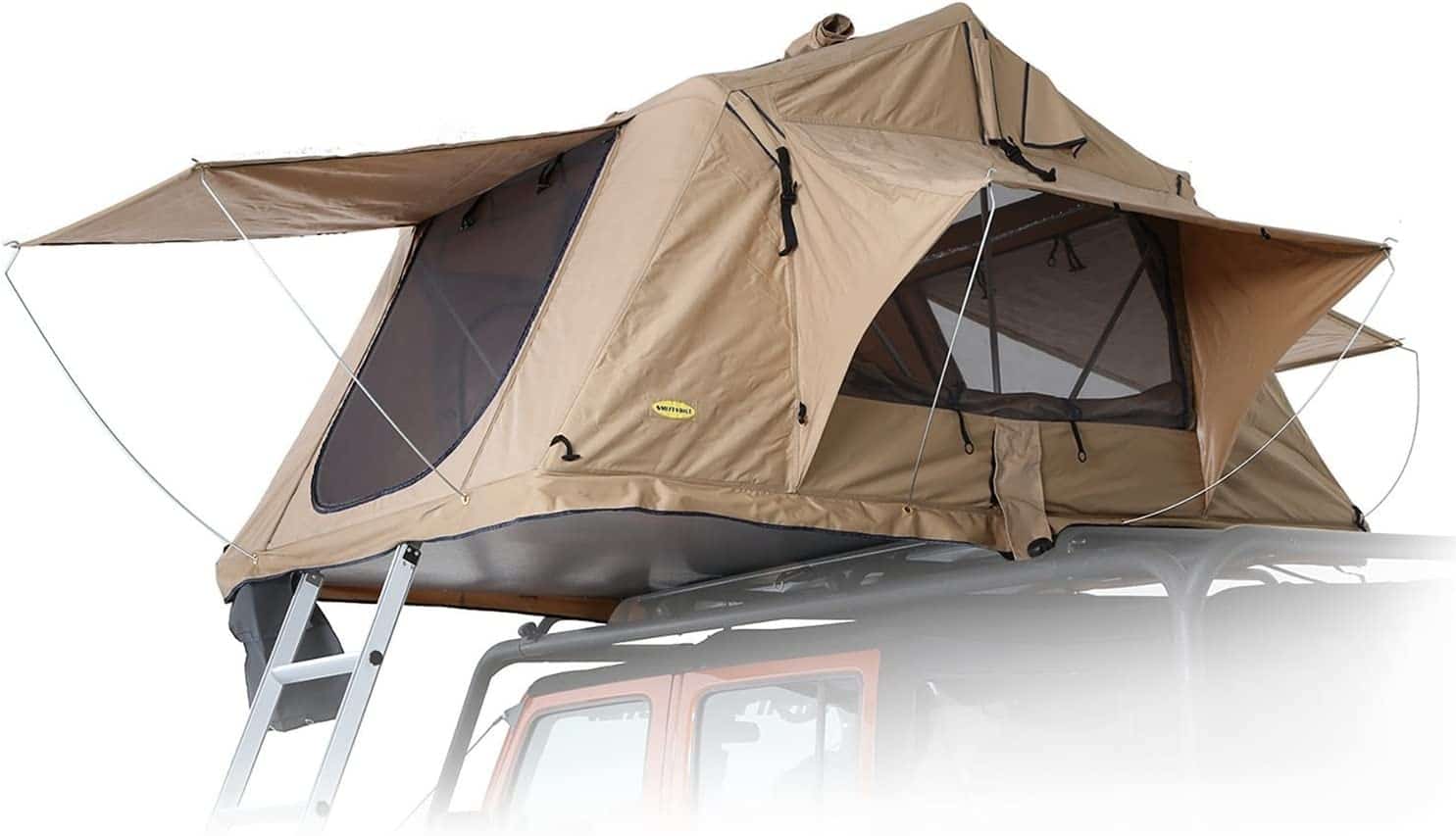
Unlike regular types which require you to pitch the tent and secure it to the ground, this type is conveniently mounted directly onto your car’s roof. It is usually lightweight, easy to install, open, or close, often featuring a hydraulic arm or telescopic pole system.
Compared to camping in a standard tent, a rooftop type gives more flexibility when selecting campsites. Your bedroom can be set up right on top of your vehicle without preparation.
This makes such tents particularly suitable for remote areas or places prohibited from ground-level camping and road trips. The downside is that certain types may not protect against strong winds or heavy rain, preventing several days in troublesome weather conditions.
14. Canopy tents
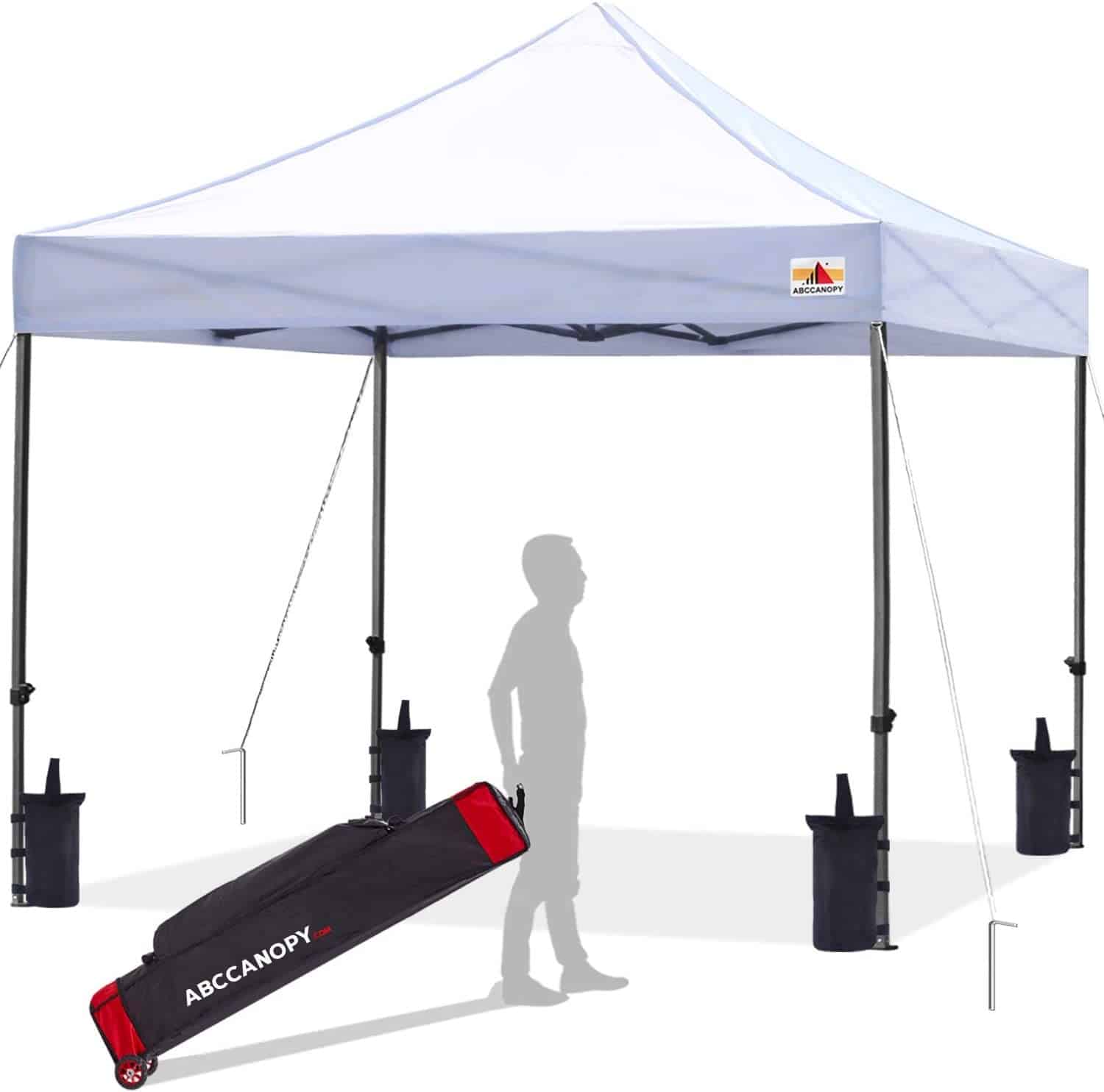
A canopy tent has an open area that distinguishes the fly and the tent body. It’s similar to an awning or pavilion, and is an ideal choice for activities like picnics or beach camping.
This type of tent typically has two poles that support two parallel arches, creating an expansive covered space that acts as both shelter and a communal area.
Generally suited for outdoor events or seasonal camping, canopy tents are quick and straightforward to set up, making them a great option for large gatherings or family outings.
While this type of tent doesn’t offer much privacy due to its open structure, it’s durable enough for windy conditions and provides maximum visibility at night due to its height.
Canopy-style tents are perfect for camping on warm summer nights, picnic lunches in the park, or other outdoor activities requiring ample space and protection from the elements. While these tents offer superb amenities, they may not be ideal for extreme weather conditions such as strong winds or heavy snow.
15. Beach tents

A beach tent is an ideal accessory for those headed to the shore. These tents provide more coverage than a traditional shelter, and the roof design makes them an excellent choice for windy beach days.
While this type of tent isn’t as stable as other types intended for longer camping trips, it will offer some wind protection, and UV rays will be blocked by the mesh walls, which allows for better airflow.
Being visually pleasing with colorful prints, a beach tent looks like a portable umbrella with sides that are held up with various aluminum or plastic poles, depending on their size and sturdiness.
Beach tents usually have no floor making cleaning easier after each use – all you have to do is shake off excess sand or water. Furthermore, they are foldable, compact, and lightweight, making them ideal for traveling short distances.
All in all, beach tents are best suited if you’re looking for a quick escape from the sun when spending time at the beach.
16. Suspended tents
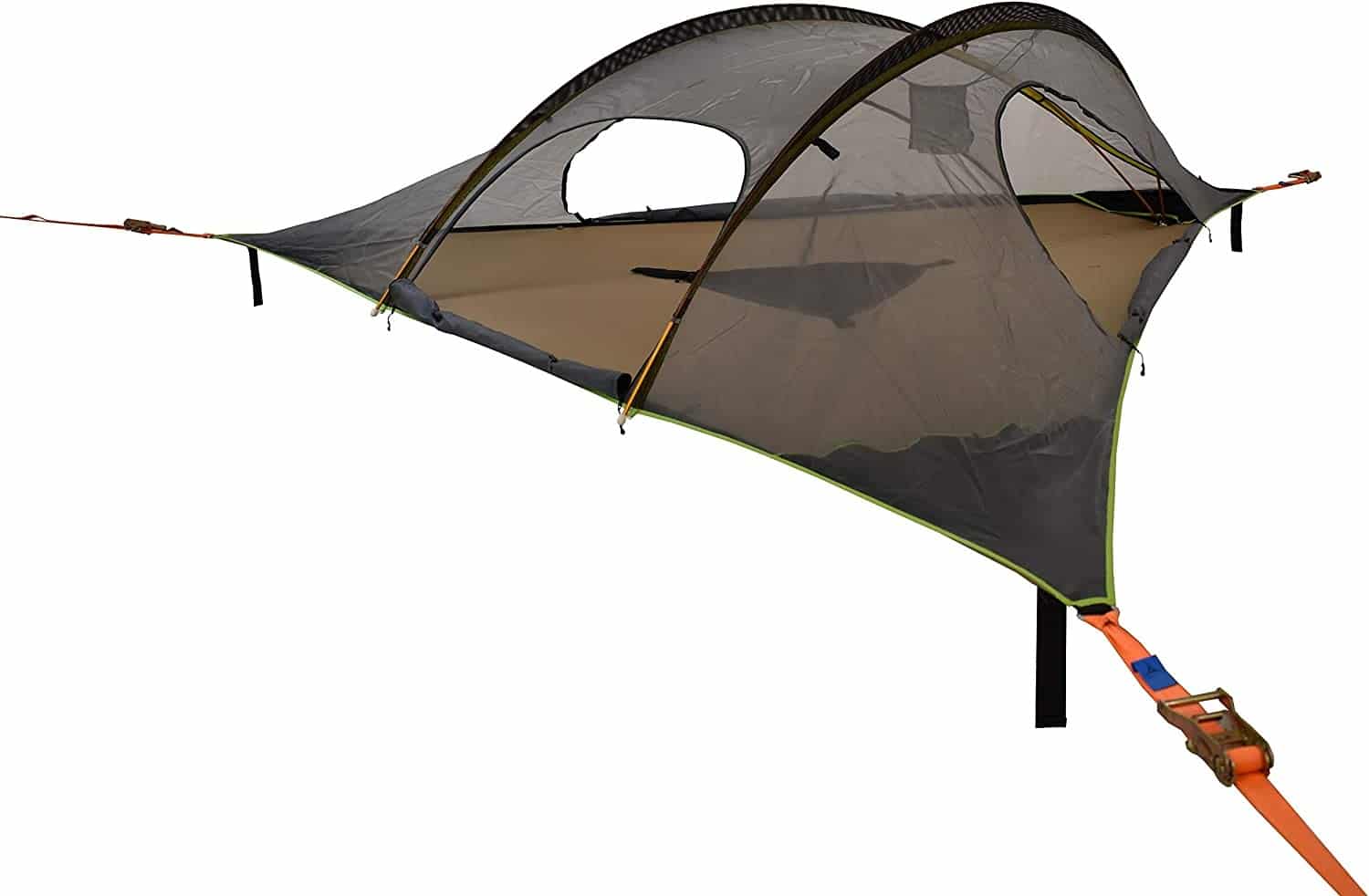
Suspended tents are most commonly made of light material and hang from trees or poles, providing campers with an open and airy feel. This type of tent is particularly suited for mild weather conditions, as the absence of sidewalls makes it more susceptible to wind and rain.
Suspended tents have the advantage of setting up more quickly than other types, so they can be ideal when looking for a quick getaway. Though their downside is that they don’t provide much insulation and privacy, they’re perfect if you want to enjoy views on a warm summer night while still feeling connected with nature.
17. Bell tents

Bell tents are a unique variety of tents that add a touch of distinction to the types of tents available for camping and leisure activities. They look exactly as their name suggests, with an outward profile shape that resembles a bell and is rounded at both ends.
Unlike the pointed structures of most other types of tents, they have an added spaciousness thanks to their more open design. Though these types of tents appear large and heavy at first glance, they are actually pretty lightweight and easy to assemble with just one person needed.
A bell tent also offers an improved protection from wet weather because when pitched correctly, it forms an air chamber that traps warm air inside, which better resists temperature changes between night and day.
Not only are these types of tents suitable for camping, but you can also use them in decorative applications, including glamping retreats or events with special effects.
18. Hammock tents
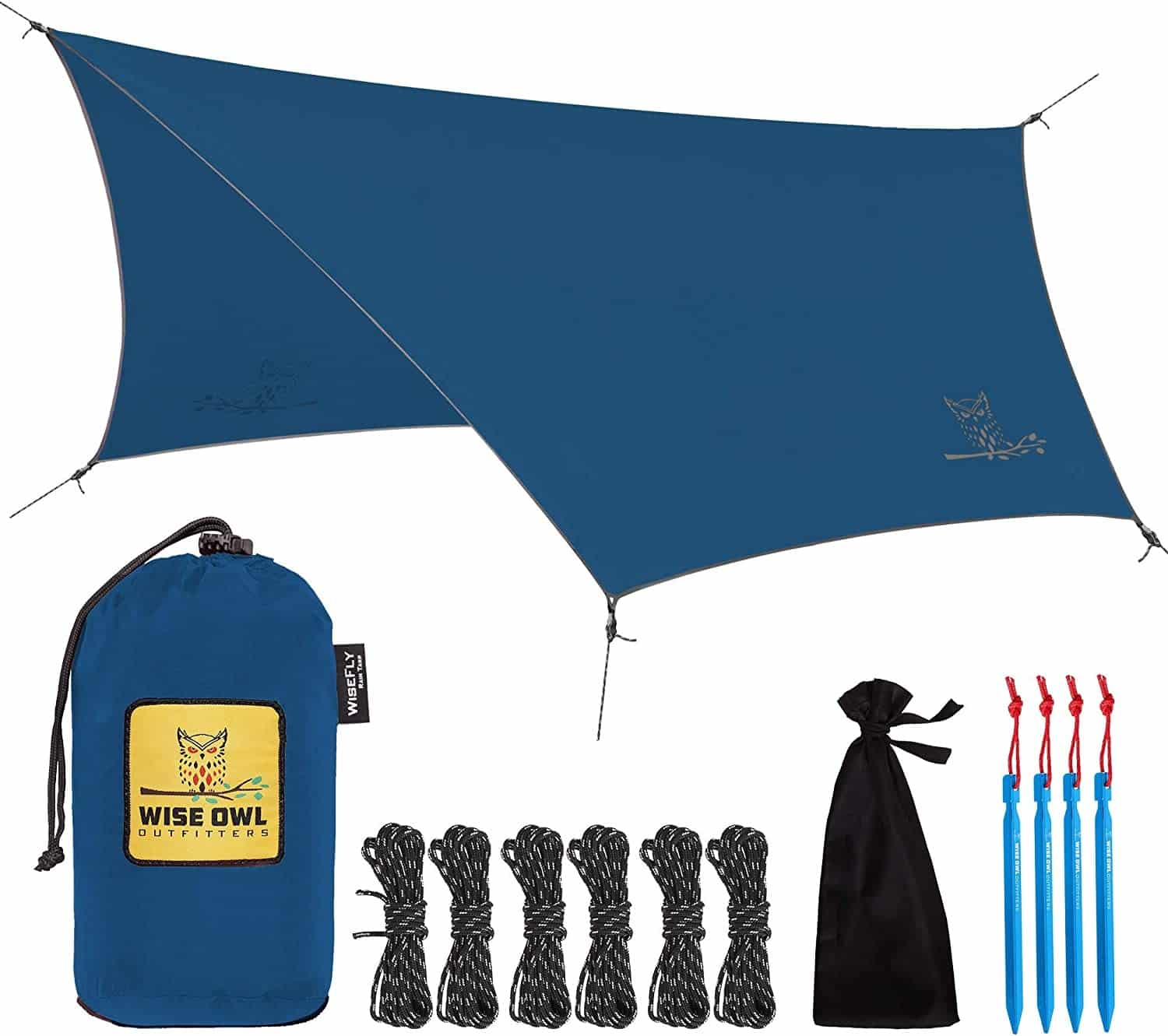
It’s different from other types of tents in how it hangs above the ground, suspended by straps or carabiners, instead of resting on an even surface like many other types of tents.
From afar, a hammock tent looks like a canvas cocoon, hung between two trees or posts, and is suitable for campers looking for a lightweight and portable option that doesn’t require much effort to set up.
Its low-lying structure also helps prevent cold airflow from reaching the sleeper, allowing them to stay warm throughout their camping trip.
On the other hand, its open bottom may not be suitable for some areas where water may accumulate during storms or rainy weather.
Check out our blog post on the hammock camping where we cover all the ins and outs of this camping style.
Ultimately, a hammock tent offers an exciting and comfortable way to lounge outdoors without worrying about camping gear such as sleeping bags, stakes, and poles.
What to look for when choosing a tent
Now that you have so many types of tents in your hands, some confusion that comes with selecting that special one is totally legit. Let’s break it down – here are the major aspects to look for!
Size
Think about how many people will live inside the tent with you. You’ll need enough room for you and your companions to sleep comfortably. And some space for your camping gear.
If it’s only you and a plus one, you can easily go for a backpacking or a suspended tent. Other types, like dome or tunnel tents, will be a good choice for a family. Multi-room, cabin, and bell tents should be your go-to for any groups beyond that.
Ease of setup
When out to the wild, the ultimate goal is to enjoy the outdoors rather than spend time constructing your shelter. Some tents will have more poles than others (and some like pop-up tents won’t), so consider your skill level and how much the quick setup is a priority and make a decision.
Naturally, the more sophisticated and larger the tent, the more time it’ll take to set it up.
Height
If the only time you’re planning to spend inside your tent is while asleep, then headroom isn’t your concern. But if you’re searching for a more livable shelter to chill inside and move around throughout the day, then height is a metric you should bear in mind to avoid constant bending and inconvenience.
Ventilation
One of the most unpleasant scenarios you can find yourself in is waking up in a puddle of sweat without any fresh air whatsoever. And the way to avoid it is to choose a tent with sufficient ventilation that comes through mesh panels, windows, or doors.
Unless your plan is camping in cold climates where heat resistance is a top one priority.
Planned use
Are you up to ground camping, relaxing on the beach, or heading out with your pick-up to sleep in it? Or maybe luxury glamping in the middle of the woods is the plan?
Every use case has its best tent type, so give it a thought before making a purchase.
Material
Again, how and where you plan to use your tent has everything to do with the material you should go for.
For example, canvas is the most rigid fabric that’ll withstand any weather conditions and will be the best choice for winter. If you’re aiming to save weight while getting top quality, look for nylon tents, but keep in mind that they won’t be that good at insulation.
Price
Finally, the more features a tent has and the better quality materials are, the more expensive it’ll be. However, plenty of reasonably priced tents offer good value for money without sacrificing quality.
Also, think about how often you’re going to use your tent. Occasional camping trips will probably do fine with budget options, yet it’s worth investing in a more durable, solid tent for frequent use. After all, quality gear can save you lots of money later.